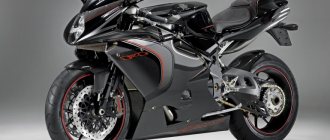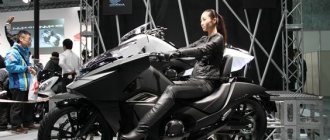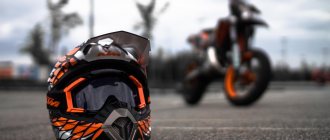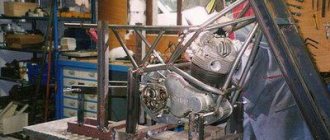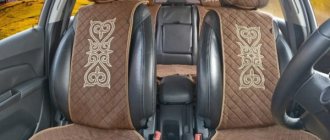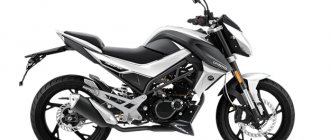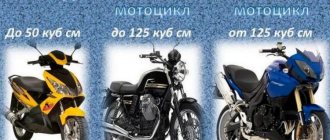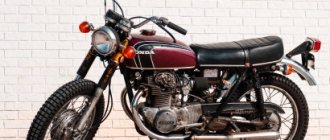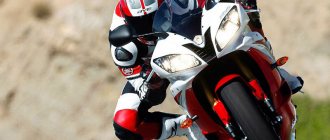- Motorcycle technical inspection
- Legal purity
- Check through the traffic police
- Through FNP
- Via RSA
- Via BKI
- Checking through the AutoHistory service
- What's in the report
Any used vehicle must be checked for legal cleanliness and technical condition. This will avoid financial problems and even liability for purchasing a problematic motorcycle.
What should you do before buying a motorcycle?
It just so happens that, regardless of what we want to buy for ourselves, before such a purchase, especially equipment or electronics, it is necessary to know about it not only its cost, but also a number of other important parameters, so that in the future this purchase does not become a disappointment for us. This rule is mandatory especially before purchasing complex equipment and, of course, a car. But many of us believe that when purchasing a motorcycle (especially when it comes to such a purchase by a novice driver), there is no point in devoting a lot of time to a detailed study of this motorcycle equipment, which usually happens when purchasing a car.
See also: The best concept motorcycles
In the end, as you might have guessed, it turns out that such a rush usually leads to numerous mistakes, especially for those who make their first purchase of automotive equipment, in this case, a motorcycle. Subsequently, this all leads to problems and disappointment for the given acquirer (buyer). To prevent this from happening, every novice motorcyclist must follow a number of very simple but reliable rules, which we will talk about with you today.
Before embarking on this review of tips and rules that must be followed before buying a motorcycle, we invite our readers to familiarize themselves with an instructive story from the life of a motorcycle seller.
Several years ago, our respected colleague worked as a sales manager for Honda motorcycles. Here's what he told us interesting.
“I worked as a motorcycle salesman for 5 years and during this time I had the experience of communicating with professionals
motorcycles, and with fans of this transport. Unfortunately, most of the people who come to buy motorbikes are not sufficiently informed about what they are purchasing for themselves. In the future, this lack of awareness often led such unfortunate buyers to disappointment in their purchase. Many of the buyers were exactly the same contingent as novice drivers; they all decided to buy their first motorcycle for the first time. I was surprised that most of them did not think about the purchase in advance and quite reasonably believed that a beginner could buy any motorcycle without hesitation.
And this is taking into account the fact that the cost of many motorcycles was comparable to the cost of some new cars.
Most of all, I remember this incident that occurred during the sale of a motorcycle that the father himself wanted to purchase for his young son.
The father of this young motorcyclist came to the salon with him, who pointed his finger directly at the Honda motorbike, which in its principle and in general was initially simply not suitable for a novice motorcyclist, since its fit, power, etc. The parameters are not for those who are just starting their life in the motorcycle world.
For my part, of course, I decided to immediately warn this dad that it is advisable for a beginner to give preference to a simpler motorcycle model. But the boy’s father did not want to listen to all my instructions. As a result, after some haggling, we came to an agreement and went to sign the documents together, and this motorcycle went straight from the showroom to the service department for a final check.
The most surprising thing about this sale is that the child’s father, after signing the purchase and sale agreement, was still dissatisfied. He was specifically convinced in his heart that during the process of this transaction I had somehow deceived him. It is quite possible that this mistrust was the main reason why he did not listen to my competent advice to purchase another model of motorbike.
After signing the contract, I asked him directly if he would like to purchase insurance for his son and the new motorcycle he had just purchased. He immediately looked at me with such an angry look, as if he and I were right now preparing for a fight in the ring, then I no longer remembered about insurance.
Then he and I went out into the street together, where their new bike was rolled out from the service center. The boy's joy knew no bounds. Certainly. This is his first motorcycle in his life, what can I say... It’s no wonder that this young boy immediately decided to try to ride it. Naturally, I asked his father whether the boy had a license and whether he had enough experience to ride this motorcycle on his own? Grumbling something under his breath, the father answered me that of course his son had such experience and my question was simply stupid.
A child (quite a young man), without a helmet and without a protective suit, got on a motorcycle, started the engine, depressed the clutch and unscrewed the gas, then abruptly released (reset) the clutch. In the blink of an eye, a powerful motorcycle flew out of the parking space and, having flown several meters, immediately flew into a wooden fence that bordered the territory of the motorcycle dealership.
From the impact, the fence immediately bent and fell, and the boy and the motorcycle flew in the opposite direction and also fell on the asphalt.
Luckily for us, when we ran up to the boy we saw that everything was fine with him. His father, making sure that his son was not injured, immediately demanded that I roll out another new motorcycle into the parking lot, blaming me for everything that happened. My father believed that it was I who was to blame.(?)
Naturally, while maintaining my composure, I calmly reminded him that just 10 minutes ago I offered to buy him motorcycle insurance, which he categorically refused.
I also reminded the child’s father of the following: the purchase and sale documents were personally signed by him, and the money for this bike (motorcycle) had already been deposited into the cash register. So, in this way, according to the law, the motorcycle was legally already considered the property of a specific buyer. Therefore, replacing the motorcycle is out of the question.
I stated that repairs to the motorcycle should be carried out at the expense of the buyer himself. As a result, the father and son, refusing repairs at our dealership, pushed this damaged motorcycle into the trailer of their car and left, naturally blaming us for all their troubles, promising our company legal action, etc. troubles. I never saw them again in our motorcycle showroom.
Thus, this day will be remembered for the rest of my life.” How do you like the story, friends?
This story suggests that before buying a motorcycle, it is important to know for sure how well a novice buyer can drive a motorbike..
It is also important to follow a number of other rules before purchasing a motorcycle so that the purchase of motorcycle equipment does not become a complete disappointment for you. Therefore, friends, you should definitely remember that before you buy your first motorcycle for yourself, you must do a lot and learn a lot. After this incident, our colleague saw a lot more mistakes made by novice drivers that motorcycle buyers make. Much to their regret or disappointment, they almost never listen to the manager’s advice.
Therefore, in order not to turn into the same father or his son and not repeat their mistakes (as well as a number of other mistakes), you must always follow certain rules and then buying your first motorcycle will not become a headache for you.
MY MOTORCYCLE
1) Do not pre-heat the engine, start it yourself when cold. We listen to the engine while it’s cold, look at the ease of starting and use it to evaluate the performance (of the carburetor and spark plugs)
2) Engine. Operation at idle (should not stall, unstable idle is also bad, but after warming up everything should work perfectly)
Ideally, check the compression.
Check consumables (the main thing is how often they were changed)
Timing chain noise (not terrible, relatively cheap and easy to change, but a reason for a serious reduction in price)
Valve knocking (if strong, then severe wear of the camshaft is possible)
Oil leaks from under the engine (drive sprocket seal, gearshift lever, leaks from under the bottom (breakage of bolt heads when changing oil), clutch cover. (consequences of unqualified repairs)! The cover gasket must be without traces of sealant (again, not scary, It’s just evidence that they climbed into the engine)
When cold, unscrew the engine filler cap and smell. There should be no smell of gasoline. If there is, the carbs have been pouring for a long time and heavily (or the needles are stuck or they are messed up with the wells).
3)Cooling system. Severe damage to the radiator. The presence of coolant in the expansion tank (very often it is not there) Oil in antifreeze in the expansion tank and the presence of the smell of gasoline there (signs of a blown cylinder head gasket and driving on oil with antifreeze)
4) Gas tank. We put our nose into the tank to check for excessive rust inside and the operation of the lid lock. If there is a lot of rust - REFUSE to buy - then you will be tortured to clean the carburetors (injector nozzles)!!!!
5)We check the wear of the chain and sprockets, and also the chain for uneven stretching!!! (to do this, check the chain tension, then roll the motor a little forward (5 centimeters) and again check the chain tension. So 6 times, if during each tension check it was not is the same, then the chain is unevenly stretched (Reason for reducing the price, because this is a replacement of the chain and sprockets).
6) Clutch We start the engine, fully depress the clutch, engage first gear, and you can add a little gas. If the engine tries to roll even a little while the clutch is depressed, it’s bad (it can jerk at most once when the gear is engaged - this is normal).
7) Brakes Front discs. New - 4.5mm, minimum permissible thickness 4.0mm Rear disc -5.0mm, minimum permissible thickness 4.5mm (on different motorcycles, the minimum thickness may vary slightly - the minimum permissible thickness of the disc is stamped on the disc itself. Look carefully)
The condition of the calipers, the presence of rubber caps on the bleeder fittings, the integrity of the boots on the pistons, broken caliper studs.
8) Suspension. Condition of the rear shock absorber rod, presence of oil leaks. Sinkholes, deep scratches, other severe damage to the front fork stays. Leaks from under the seals, torn boots.
A noticeable knocking sound in the fork when swinging - breakdowns (press the front brake, rock it up and down)
9) Tires . Tread condition, uniform wear, dents and cracks on rims
10) Body Condition of the paintwork on the tank, non-standard color, increased thickness of the paintwork on the tank in areas of potential damage.
Rubber pads on the footrests. Wear should correspond to mileage. over 20-25 thousand kilometers they are half erased.
Scratches around the ignition switch. The 10-thousander has only a slight scratch, while the 50-thousander has a wide stripe without paint.
Cracks in the frame, subframe (look at the engine mount, subframe mount to the frame, base of the steering column. Ask to remove the saddle).
11) Electrical Operation of instruments (stops, lights, turn signals, rear brake light switch, neutral sensor, running board.)
The battery must be charged, excuses that it sat for a long time and no one started it will not work.
12) Documents Check numbers. Carefully look at the numbers on the frame and engine for interruptions and ambiguities in reading.
13) TRADE. When inspecting the motorcycle, note any defects out loud so that the seller can hear. Listen to what he says! Perhaps he has this replacement part, or he himself will offer a lower price. And in general, immediately clarify what goes with the motorcycle, what will be given “in addition”, what can be taken for extra. fee??? If you are satisfied with the first stage (external inspection), proceed to the second (walking, for example), if the second passes, check further, etc. If you don’t like it at some stage, it’s better to immediately say so and not torment anyone else, not the motorcycle (what if I hear it and still like it!?) or the seller. If you are generally satisfied with the motorcycle, feel free to offer your price! Be sure to give reasons why you would like to receive a discount. You shouldn’t reassure the seller like “I’ll think about it later.” Think immediately, consult immediately and make a decision! If, after such a statement, you went and bought a moto in another place, the rule of decency would be to call the person you told that you would think about it. You liked everything, but the seller needs time!? Leave a deposit. If you leave a deposit, agree on all the conditions. If the seller sold the vehicle to a third party, then let him give double the deposit! If you bought a vehicle from a third party, forget about the deposit! That's what it's done for! So, here are some brief tips on inspecting a used motorcycle)
author Nikita Beregoi
Get professional training.
Before you start thinking about buying your first motorcycle, first get quality training at a driving school and get a category “A” license. Remember that when you go out on the road driving a motorcycle without a license, you are not only grossly violating the law, but also becoming potentially dangerous to everyone around you.
So remember, friends, until you complete training at a driving school and receive your license, you should forget about buying a motorbike. Never rush. You will always have time to put the long-awaited motorcycle in your garage. The most important thing for you is the ability to drive motorcycles and, of course, a category “A” driver’s license.
Remember, although riding a motorcycle is a fun and more exciting spectacle than driving a car, driving a vehicle (car) has always been considered safer; it does not require the same driving skills that are necessary when driving a motorcycle.
So remember, even if you are a professional car driver, do not think that driving a motorcycle will be an easy task for you, that you will quickly and easily gain experience in such driving. This is far from true. Driving a motorcycle is a completely different world and a different driving technique.
If you still could not resist the temptation and did not complete your training at a driving school in category “A” (motorcycle), purchased your first motorcycle in advance, then under no circumstances, until you have completed full training at a driving school and received a license get behind the wheel of your bike. You will always have time to do this. And even more so, you need to remember, under no circumstances and under any pretext do you think about driving onto the road. It is very dangerous!
How to buy a used motorcycle: a ready-made checklist
If the seller asks for too high a price and does not agree to reduce it, even after all the identified disadvantages, feel free to send him on a walking trip. There will be other, more respectable sellers, and in principle, purchasing a motorcycle does not require any rush. Write in the comments what else you can check, we’ll add it to the list and put together a complete checklist.
Both novice motorcyclists and motorcyclists with quite a lot of experience often find themselves in a situation where an insufficiently thorough inspection and superficial tests of the purchased product put them in an uncomfortable financial situation. This, in turn, is fraught with disappointment in the purchase, or even in your idea (for beginners).
What is more profitable: cashback on a card or bonuses?
BonusDiscount
Which motorcycle should I buy?
Motorcycles, by their nature, have much more specializations than cars. Each group of motorbikes is developed for certain operating conditions, as well as for certain sports, etc. applications. In the auto world, we can buy ourselves a Mini Cooper S, which, despite its urban specification, is capable of calmly driving along a dirt road and taking you to the same dacha.
But if you buy a sportbike and want to ride it to the dacha along a rutted country road, then it is not a fact that you will quickly get there (if at all) to your country house. If the road to your dacha is completely muddy, then a sportbike is unlikely to suit you here. Therefore, before buying, remember, you first need to decide what type of motorcycle equipment you need, and taking into account all your needs. If you are going to ride on country roads every day, then of course you just need to forget about a sportbike.
Regardless of what specification of motorcycle you want to buy, you must initially conduct research and preferably several models and brands of motorcycles that are available for purchase in your region. Determine for yourself right away in what price category you are ready to buy a motorbike. Also determine who will service your bike - a dealer, an unofficial technical center or yourself. This will directly determine where you will need to buy motorcycle equipment.
In addition, study on the Internet using certain search engines all the pros and cons of a particular motorcycle (motorcycle), that is, study various forums, reviews of motorbikes on various forums and read review test drives about them. Your first priority before purchasing a motorcycle is to find out about the reliability of this motorcycle, its problems, etc. complaints or advantages that you may encounter after purchasing a particular bike model.
How to Ride a Motorcycle - Step by Step
If you notice online that people often complain about a certain bike model, that is, for example, they say that there are constant problems with the motorcycle, especially with the generator, then this is a clear hint to you that you should not purchase this modification of the bike .
Friends, we draw your attention to the fact that many test drives published and published on the Internet, for the most part, never reflect the ideal subjective opinion that one would like to hear and read about.
Firstly, many articles on the Internet are specific hidden advertising of a product, which is paid for by leading motorcycle companies to virally promote this product to the masses.
In addition, you know that people's tastes and opinions cannot be the same. Therefore, we must remember that this or that review on the Internet only shows the private opinion of the journalist or specialist who conducted this very test drive.
So remember, it is preferable to study everything in detail about motorcycles on online forums dedicated specifically to motorbikes, where you can see many reviews from real motorcycle owners.
Another piece of advice, friends: - you don’t need to buy a motorcycle that you don’t need at all. For example, if you are not a professional motorcycle racer, then you do not need to buy a super-powerful motorbike, but just buy yourself a motorcycle with average power. If you are not into motorsports, you are unlikely to need a motorbike with an engine capacity of more than 900 cc.(?) Even if you want or are eager to become the owner of such a powerful motorcycle, you will still need an engine from 650 to 900 cc .
If you are a new driver, then trust us that power is your first and foremost enemy. Your task at first is to gain more experience in driving a motorcycle.
Friends, you should also not buy a large motorcycle, since due to inexperience it will be very awkward and uncomfortable for you to drive such a large, heavy and powerful motorbike.
When you grow into something bigger, you will definitely be able to buy yourself something more powerful and more worthy. In the meantime, don’t rush and don’t overpay extra money for all those options that you, as a beginner, are unlikely to need at first.
Sale of a motorcycle by an individual entrepreneur.
There is nothing wrong with an individual entrepreneur, but you need to understand two things: 1. The individual entrepreneur sells motorcycles professionally. Activities have been put on stream. 2. The motorcycle can either be imported from Japan/Europe/USA, or assembled from spare parts after an accident - otherwise there is no money to be made.
If, according to the documents, you are the first owner in the Russian Federation, then everything is ok, but if you buy a motorcycle from an individual entrepreneur, and several owners in Russia are already included in the title, especially carefully check the frame and other structural elements of the motorcycle that suffer from an impact or fall. It is possible that the individual entrepreneur simply bought a motorcycle that was being sold at a bargain price from some oaf with the note “I have a wife, children, I want to live.” But there is also a good chance that this is a motorcycle restored after an impact/engine wedge.
New or used?
Most likely, after this part of the article, what our readers will read further, certain motorcycle enthusiasts will not be very happy with our expressed opinion. But still, definitely, and there is a reason for this, we believe that the first motorcycle should be used. Why? We answer. Firstly, if, after some training in driving a motorcycle and after obtaining a category “A” license, it turns out that riding a motorcycle is not your thing, then selling used motorcycles is much easier than selling a completely new motorcycle. The thing is that the demand for motorcycles in our country leaves much to be desired, and since a used bike costs much less than a new one, it will be much easier to find a buyer for it.
Moreover, a new motorcycle purchased for yourself seriously loses its price in the first year of operation. Thus, we believe that while you still don’t know whether you will like this very motorcycle world, you should first buy a used motorcycle for yourself, and not a new one.
Secondly, for the initial acquisition of independent motorcycle riding skills in the first year, it will not matter to you which motorcycle you ride. And in this case, it will naturally be preferable to buy a used motorbike.
In addition, due to your limited driving experience, this motorcycle may fall and be damaged. If you damage a new motorbike, the loss of money will be quite large, and repairs will cost you much more than the same used motorbike.
Plus, maintaining a new motorcycle will cost you much more than a used bike. And according to the same statistics, beginners rarely damage their motorcycles in the first year of ownership. So we recommend that it would be more expedient and smarter to buy yourself an initially used motorbike.
Front fork
THIS DETAIL also requires attention during inspection. It is convenient to check the fork on the motorcycle when it is standing on the center stand. Have someone push on the back of the bike or just sit in the passenger seat. When the front wheel begins to spin freely in the air, grab both legs of the fork as close to the bottom of the fork as possible and wiggle it. If the fork is heavily worn, you will immediately feel it by the beating of the feathers in the guide bushings.
In addition, the fork may dangle in the steering column (due, in all likelihood, to the fact that the upper and lower bearings have “run out”). This seemingly innocent play can turn into a tragedy on the highway. At a decent speed - usually well over a hundred - the front wheel suddenly begins to “walk” from side to side in an ascending amplitude. Most often this ends in a fall. Therefore, if you discover such a defect, be sure to bring it to the attention of the manager and agree either to carry out repairs before selling, or to receive an appropriate discount. But worn bearings must be replaced immediately.
On motorcycles that are not equipped with a center stand (such as sportbikes), it is more difficult to check the front fork. A well-equipped service center must have a special stand for this.
After you've held the chrome ends of the fork legs, look at your hands to see if there are any traces of oil on them? If there is, it means the seals are leaking and, as a result, the fork hydraulics may not work properly. And in addition, the oil, flowing down the feathers, will certainly end up on the brake pads. And oiled brakes have never brought happiness to anyone...
Buy the motorbike that suits you best.
Unlike cars, which have adjustable seats and an adjustable steering wheel, many motorcycles do not have different adjustments for the comfort of the driver and passenger. So, friends, don’t expect that when you buy any motorcycle, it will be comfortable for you and it will be comfortable to sit on. For the most part, you need to know that you will sit on the motorcycle in exactly the position dictated by the design itself and its manufacturer.
See also: Ten best motorcycles for a beginner
Sportbikes and cruiser motorcycles are designed in such a way that the rider's body is leaned forward. The tilt angle behind the wheel of such motorcycles is quite strong. People end up slouching a lot when riding these bikes. It is quite possible that driving a sportbike will not be very comfortable for you. Therefore, remember, before buying a sports bike, you must check its comfort, whether it is comfortable for you to sit behind the wheel.
We also draw your attention to the fact that it may not be possible to immediately determine whether this sport bike is convenient for you in these few minutes in the showroom.
The point is this: if you feel quite comfortable while sitting behind the wheel of a sports bike in these minutes, this does not mean that you will also be comfortable behind the wheel further, for example, after half an hour or several hours while driving it.
Sitting motionless in a motorcycle showroom and riding this motorcycle for a long time are not the same thing at all.
Of course, the most important parameter for the convenience of a motorbike for a novice driver is the height of the motorbike itself. If, while sitting behind the bike, both your feet touch the asphalt, then this gives more confidence to any novice motorcyclist who, at first, is very afraid of traffic lights, where they have to stop and get to their feet. It will be much better if a novice driver touches the road with both feet rather than touching it with one foot. To do this, you need to buy for yourself a motorcycle that is not tall (with a low seating position).
The second important factor in choosing a motorcycle is the weight of the motorcycle. Remember, friends, that the heavier the bike, the harder it is to control at low speed. Thus, based on this parameter, we do not advise novice motorcyclists to immediately buy a heavy motorbike as their first motorcycle.
Frame
KEEP IN MIND: no matter what modern slipway the damaged frame is corrected, no matter how much they assure you that this part has been brought into complete order, it will never be the same. If we compare a motorcycle with a living organism, then the frame should be likened to a spine. The spine must be healthy and, most importantly, smooth. From this point of view, it is necessary to consider the frame, carefully inspecting it from the steering column to the rear swingarm.
Frames can be made of steel, round or square pipes, or aluminum. In any case, on a “healthy” frame there should be no traces of impact, no dents, no welds where they are not supposed to be. It is more difficult to see traces of a fall on sportbikes - their frame is covered with a fairing. When in doubt, ask to remove the fairing, especially if you notice that its parts are held together by non-branded fasteners. It is likely that after the accident, the repaired and painted fairing was used to cover the damaged frame.
But it happens that no traces of an accident remain on the frame, but nevertheless its geometry is violated. I have a simple test for this. When the seller demonstrates the motorcycle in motion, ask him to slowly drive towards you several times. And, squatting down, look: are the wheels lying in the same plane? The method is primitive, but quite suitable if you don’t have a laser device at hand that will find all the base points of the running bike. If you have the slightest doubt, say thank you to the seller and go look for another motorcycle. You're not a kamikaze...
Take a test drive before purchasing.
Of course, in order to understand whether this or that motorcycle is right for you, you must first conduct a real test of it, that is, get behind the wheel yourself. But the problem here lies elsewhere; many motorcycle dealers will never agree to give you the opportunity to test a motorcycle in real conditions. This is not a car.
However, friends, this test is very important. After all, having read about this or that model of motorcycle bikes, even all the available information, having fully studied the reviews of the owners about them, you will not get a real idea about this motorcycle until you personally ride it.
The only opportunity to drive such a motorcycle, the exact model you have dreamed of and want to buy, is to join a motorcycle club in advance or undergo training at a driving school where exactly these models of motorcycles are used. Also, perhaps one of your friends or acquaintances has such a motorcycle and they will be able to give you the opportunity to test this type (model) of a motorbike, at least for a few minutes.
Tires
MODERN motorcycle tires begin to work at full strength (stick to the asphalt) only after they warm up while driving. The material from which they are made is similar to the rubber used for Formula I cars. On bikes older than five years (even if they have barely been ridden), you can see a thin web of cracks on the sidewalls of the tire - traces of a long stay in the open air. Such rubber becomes like plastic and stops holding the road. That is, you need to prepare to buy a new set of tires. A legitimate reason to ask for a discount.
If your tires look like new, it's more than likely that they've just been treated with an old tire care product. This trick is easy to expose. Run your finger over the tire. If it looks like it has been soaped up and there is a dirty, greasy mark left on your finger, then the fresh appearance of the wheels is a fiction. By the way, driving on such tires is extremely dangerous, especially in corners: its sidewalls remain slippery for a long time from the “chemicals”.
Preparation: Proper equipment.
As we have already told you, all motorcycles are much more dangerous than cars.
And falling off your bike can pose a threat to your health. Therefore, before you buy a motorcycle, be sure to take care of protective equipment, from a helmet to gloves and the same suit. Please remember that you cannot save on equipment. The more expensive the protective clothing, the better for you. For example, a motorcyclist's jacket must have a certain property, namely, to absorb external influences, for example, in the event of a fall. Including, you also need high special boots and special impact-resistant gloves. Don’t forget also about special pants that will not only protect you from the wind, but also protect you from injury if you fall.
Below we publish for our readers a list of five motorcycles that are considered ideal for beginner motorcyclists.
The list is very subjective, it is based on the criteria that professional motorcycle racers told us about and those motorcyclists who quite recently considered themselves beginners in motorcycle riding, but today, having gained sufficient experience, they can rightfully talk about the mistakes that they made when buying their first motorcycle.
Please note that this is just a private opinion of a motorcycle driver and in no way does it impose on anyone (any of you) to purchase this particular model(s) of motorcycle equipment(s). But still, for our part, we believe that you should still listen to this private opinion, since these motorbikes are really suitable for novice drivers in many of their parameters.
Types of motorcycles
Sports
They have a streamlined design and beautiful design. Designed for one passenger with a seating position that implies a strong forward lean of the body and emphasis on the steering wheel. A second person can fit in the back, but will hang off at the very edge.
Sports models are characterized by high speed and aerodynamics. Suitable for people of all ages who love fast driving on the highway.
Advantages:
- stylish;
- powerful;
- speed up to 300 km/h;
- large wheels;
- suitable for the city and highway;
- high saddle.
Flaws:
- to repair, it is necessary to remove a lot of trim;
- it is not very comfortable for the second person to sit;
- the small windshield does not protect well from midges;
- Riding in a forward position for a long time is tiring.
Classic
They have compact dimensions and a comfortable vertical fit. They are easier to repair and maintain because they don't have as many aerodynamic fairings. Two people sit quite freely.
Such motorcycles are chosen for commuting to work or small trips to a neighboring city or fishing. They are suitable for young and old people for everyday use in order to save on transport and avoid getting stuck in traffic jams.
Advantages:
- comfortable fit;
- full two places;
- sufficient tank capacity;
- short wheelbase, increasing maneuverability;
- acceptable price;
- soft seats;
- power suitable for quick overtaking in busy traffic.
Flaws:
- most models do not have windshields at all;
- there are no handles for the passenger;
- not designed for long distances.
Tourist
These are models for conquering the roads. They are designed to provide maximum comfort when covering long distances. They are chosen by middle-aged and elderly people who want to travel in an active way.
Touring motorcycles are characterized by their heavy weight, spacious luggage compartments and wide seats designed for hours of riding.
Advantages:
- huge fuel tank;
- many little things for comfort;
- liquid cooling system;
- high speed;
- large compartments for things;
- powerful;
- windshields provide good protection from midges and dust.
Flaws:
- high fuel consumption, like a car;
- long wheelbase, increasing the turning radius;
- very heavy.
Off-road (cross)
These bikes are designed for extreme sports. The high tread, saddle and huge wheels allow you to ride it on dirt and sand, perform jumps and turns. This is a vehicle for young people who want to learn a new hobby or real athletes.
Advantages:
- long length of shock absorbers, providing softness when jumping;
- large wheels;
- high tread with good lateral grips;
- sufficient power for fast acceleration;
- convenient for tall people;
- There are models with six speeds;
- good cross-country ability.
Flaws:
- one seat for the driver;
- loud engine operation;
- small fuel supply.
Suzuki SV650.
This bike itself is narrow and quite light, which will help beginners quickly gain riding experience. In addition, the engine of the Suzuki SV650 is reliable and easily copes with the mistakes of beginners. This is quite a small and good motorcycle bike. But this size is ideal just for the duration of training and for gaining sufficient experience for the subsequent purchase of more serious equipment. Thus, until your skills become better and more confident, you should not buy a large and heavy motorbike for yourself.
In addition, this motorcycle has quite a variety of spare parts and components. Please note that you should purchase only those models that are equipped with an anti-lock braking system (ABS), which will help a beginner avoid accidents and falls.
This model can only be purchased in used condition (the model has already been discontinued). The ABS system appeared on this model in 2007. The average cost of a used model in Russia is approximately 250 thousand rubles. Here are private advertisements for the sale of this model.
Questions to ask
If you are buying a used motorcycle, ask questions about its technical condition.
- When was the motorcycle brought to Russia?
- How many owners have changed?
- What oil was used?
- How often did you change the oil?
- Where was the motorcycle stored?
- Which service centers carried out the repairs?
- Do you have documents for the motorcycle?
A conversation with the seller will help you see how the equipment was treated. It’s good if there were few owners, one or two. And if the motorcycle was brought not so long ago, and there were quite a lot of owners, then this is already alarming. Please note that the chances of finding good motorcycle equipment that arrived in Russia 10 years ago or more are low. Older motorcycles have their own ailments that you're bound to feel, and parts for them are hard to find and expensive.
Triumph Bonneville.
Another motorcycle model that is ideal for novice drivers. Thanks to its low stance, powerful engine and handling, and the model's undeniable reliability, the novice motorcyclist will not feel uncomfortable behind the wheel of this Triumph Bonneville.
The most preferred model here is the 2012 model, which is equipped with an 850 cc engine and has a power of 68 hp.
Another thing that is noteworthy here is that this motorcycle may not only be the first for many, perhaps it will become your main motorized vehicle in the future, when you gain sufficient experience in motorcycling. Read more…
Checklist for checking a motorcycle before purchasing
So, what and in what order will it be correct to check when buying a used motorcycle and what tools or other means will be needed for this. 1. The presence, readability and geometric correctness of the frame number, which is printed on the steering rod cup. Use a magnifying glass and immediately take a photo so that later, while at the computer, you can make the necessary checks. Reliability of fastening, readability and absence of signs of counterfeit license plate.
11) Electrical Operation of devices (stops, lights, turn signals, rear brake light switch, neutral sensor, running board.)
Kawasaki 900 Vulcan.
This is a cruising motorcycle with a medium weight. The weight of this Kawasaki 900 Vulcan is 282 kg, which is quite suitable for a novice rider. The V-shaped engines of the Kawasaki 900 Vulcan motorbike are quite powerful and are considered very reliable today.
It is worth noting right away that despite the fact that the engine capacity of this bike is 903 cc, the power of this power unit for beginners is quite conservative, it is only 48 hp. Read more…
Kawasaki 250/300 Ninja.
When it comes to Kawasaki sport bikes, many experienced motorcyclists unanimously say that the Kawasaki 250 Ninja model, or at least the 300 Ninja model, is ideal for beginners. It may be too early for many novice drivers to purchase this type of sport bike, but for those who have successfully completed motorcycle driving training at a driving school and quickly began to feel quite confident behind the wheel of a motorcycle, such models will be an ideal solution for them for the first purchase of a sports motorcycle. Read more…
How to check a motorcycle before buying
- Go to the official website of the FNP.
- Select the “Find in the registry” item.
- Select the item “By information about the subject of collateral.”
- Enter the VIN number and click "Find".
On the traffic police website you can check any motorcycle registered in Russia. What information is available:
An indirect sign that this is a “combat” sports equipment is that the bolts and nuts of the most critical connections are additionally reinforced with wires. Look closely and you will see them for yourself!
Any scooter with an engine of 400 cc or higher.
Many of you will be surprised that we suggest buying a scooter as your first motorcycle? This is no joke, friends. This type of motorcycle occupies a special niche in the motorcycle world. Believe us, many professional motorcycle racers love scooters for their lightness, handling and special design. As a first motorbike for most new motorcyclists, it would be best to purchase any model of scooter with an engine capacity of 400 cc or more.
Thanks to the sufficient engine capacity and power of the scooter, you can ride it on any road.
Yes, of course, you are right in some ways, this type of equipment is not for those who need ambitions on the road, for whom it is important to show everyone their importance. But nevertheless, with this modest technique you can quickly gain sufficient experience in driving two-wheeled motor vehicles. Think about it, friends.
Transmission
There are three types of SHE on motorcycles. The first is a cardan drive (most often it can be found on heavy “neoclassics”, “touring” and “cruisers”). Such a transmission can only be checked on the go, in a test drive. To do this you will have to break the Rules and not wear a helmet. Listen to whether the final drive gears are whining in the rear axle (this can be heard already at speeds from 60 to 80 km/h). Ask the manager (or try it yourself, if you are entrusted with the steering wheel) to sharply increase and release the gas several times while driving: will there be unpleasant knocking noises - a sign of increased gaps in the splines and gears from a very long or improper operation of the transmission.
The second type of drive to the rear wheel is a chain. The condition of the chain drive is easier to determine. Grab the chain with two fingers where it fits onto the rear large sprocket, at its outermost point, and try to pull it back. If this succeeds, it means that the chain is very worn and must be replaced. The chain, which has exhausted its resource, begins to intensively gnaw on both sprockets - both front and rear. Eventually you will have to change them too.
The third drive option - a toothed belt - is quite rare, as a rule, on choppers that do not have high engine power and speed. Although I once had the opportunity to test a super-powerful “Boss Hoss V8” with a seven-liter engine from a “Chevrolet Tahoe”, in which a Kevlar belt served as a drive from the automatic transmission to the rear wheel. It is good because it requires virtually no maintenance. You just need to monitor its tension and avoid excessive contamination.
